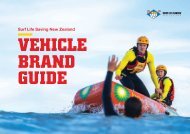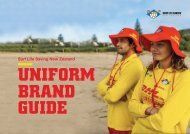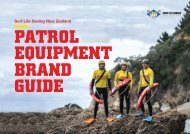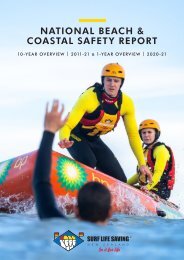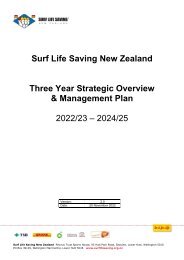National Standard Operating Procedures - Jul 2022
Full NSOP Manual
Full NSOP Manual
You also want an ePaper? Increase the reach of your titles
YUMPU automatically turns print PDFs into web optimized ePapers that Google loves.
Ensure all rescue equipment kept in state of readiness<br />
Ensure a minimum of two rescue craft are deployed for the operation<br />
Ensure IRB/RWC crews are adequately trained and prepared for offshore<br />
SAROPs<br />
Ensure IRB/RWC fully fuelled with spare fuel<br />
Ensure radios (Marine VHF capable) always charged<br />
Issue and check PPE<br />
Radio contact with home SLSC or local Coastguard, maritime radio, etc.<br />
Two IRBs/RWCs or air support e.g., rescue helicopter, fixed-wing<br />
Equip rescue assets with night rescue equipment if task duration likely to<br />
exceed available daylight<br />
PPE REQUIRED ON PERSON:<br />
Reflectorised PFD<br />
Reflectorised surf helmet<br />
Full wetsuit<br />
Whistle<br />
Rescue fins<br />
Personal Locator Beacon (PLB)<br />
PPE PREFERRED ON PERSON:<br />
Handheld GPS navigation equipment<br />
Cold water survival suits, booties, dive gloves (location specific)<br />
Energy bars and drinking water<br />
REQUIRED ON IRB/RWC:<br />
Marine VHF radio<br />
Flare pack (up to date)<br />
E<br />
Emergency<br />
Services<br />
PREFERRED ON IRB/RWC:<br />
Throw-rope<br />
GPS locator beacon<br />
Night rescue equipment (if SAROP within 30min darkness)<br />
Contact Police via 111 in any situation that requires an offshore response<br />
S<br />
Situation<br />
<br />
<br />
<br />
<br />
Gather as much information and intelligence about the incident as possible<br />
Keep informants at scene and document the phone number of informant and<br />
those lost if possible<br />
Use subject questionnaire or checklist<br />
Develop clear mission and objectives (GSMEAC)<br />
C<br />
Communicate<br />
<br />
<br />
<br />
<br />
<br />
Conduct team briefing (GSMEAC) before deploying<br />
Document all details of the crew responding out to sea and pass to Police<br />
Carry out a Dynamic Risk Assessment using the ORA tool share with team<br />
Contact Police /Coastguard/SurfCom/ before launching<br />
Conduct radio checks before deployment and file trip report (TR) with<br />
SurfCom or the Coastguard VHF stating:<br />
- Call sign<br />
- Number of persons on board<br />
- Intentions<br />
NSOP<br />
OFF SHORE MARINE SAR OPERATIONS NSOP_FINAL 140





